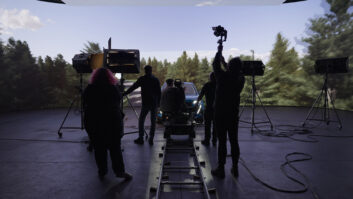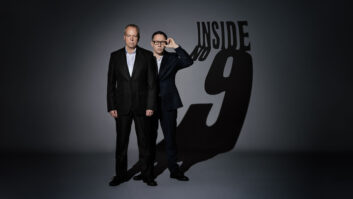
Although Norway’s state broadcaster NRK launched its first HD truck in 2006, much of the output since that time has been in standard definition. However, with the official launch of high definition transmissions earlier this year on all of the broadcaster’s channels, the call for HD OBs has obviously increased. And to cope with additional workload, a second vehicle, HD2, has just been introduced into the fleet, writes Philip Stevens.
“Its first assignment was coverage of the Nordic World Ski Championships, in March 2011,” reveals Jon-Dag Skagmo, NRK’s manager, Studio and OB Production units. “But like HD1, the new vehicle is flexible enough to cover sports, entertainment and music productions.”
The truck, which was built by Sony Europe, has an overall length of 13.85 metres excluding the tractor unit; a stowed width of 2.52 metres which can be expanded to 3.87 metres; and a height measuring four metres. Coachwork was carried out in the UK by A Smith of Great Bentley. The brief required accommodation for four vision, six replay, two edit, four main production, two secondary production and three sound operators – and with space to spare.
“In designing the layout of the vehicle, consideration was given to the fact that it would operate in harsh Nordic weather conditions,” explains Mark Carver, project manager, Live Production Solutions, Sony Professional. “Special attention is given to places where snow can collect or water can freeze; even the condensate drains from the air-con units incorporate trace heaters.”
Technically, the truck has a 3G infrastructure that makes it straightforward to produce 1080i HD programming now, while anticipating both 3D and 1080p in the future. “HD2 has been designed for 100% HD production, and we have included embedded audio with 16 channels for 5.1 production,” says Skagmo.
In fact, the audio inventory is comprehensive. A Studer Vista 9 Audio console, complete with integrated router and Riedel Artist communication matrix, was the preferred option for mixing purposes. “These are standard pieces of equipment throughout Norway for both NRK and commercial companies, and so it made sense to include them in the new vehicle to simplify integration, training and workflows.”
Other audio equipment includes a Digidesign Protools multi-track recording system, Dual Dolby E encoder and audio tools, Eventide, TC Electronic and Bicasti outboard audio effects, and a Newbury Systems camera microphone remote control.
Routing requirements
One interesting part of the audio installation involved the preferred router. “We provided a Miranda NVision 8500 hybrid embedded audio router, with a 105 x 280 3Gbps standard video matrix, 104 x 112 3Gbps de-embedding/embedding matrix, and a 3 x 4 MADI matrix,” says Tim Walker, Miranda’s product manager for Router Hardware. “The router is fitted with redundant control cards, redundant power supplies, and redundant crosspoints that protect all video and audio paths, this allows the router to operate even in the rare event of a hardware failure.”
Walker goes on, “The new truck is handling a significantly higher number of audio channels for 5.1 surround and, with the restricted space, it would have been difficult to squeeze in the required signal processing gear using a traditional routing and signal processing solution. The NVision 8500 Hybrid router’s ability to manage embedded audio processing and MADI transparently, with ultra low latency, simplified the management of the increased number of audio channels.”
In fact, NRK saved almost two racks worth of space by eliminating a separate AES router and external embedders/de-embedders. The cable management is also improved significantly, and there are major savings with respect to power and weight.
According to Walker, the router integrates de-embedding, shuffling, break-away and re-embedding in just a single frame. “This means that everyday signal processing tasks, like swapping programme audio tracks, can now be handled simply and effectively within the router frame. Advanced hybrid router cards with audio processing can be mixed with regular input and output cards to minimise costs.”
Miranda was also responsible for providing 10 Kaleido-X16 multi-viewers and three Kaleido-Modular multi-viewers to handle monitoring for the truck’s production, audio and video areas. In all, 10 large LCD displays are employed, with the reference grade monitors having LED backlight. This configuration was chosen for the displays’ overall small size, low weight, reduced power consumption, and the elimination of a regular line-up.
With Sony in charge of building the vehicle, it comes as no surprise that the company’s cameras and vision mixer form part of the equipment list. In all, 20 HDC-1500R camera channels can be used, including two HDC-3300R supermotion and two wireless chains. As necessary, the 16 ‘regular’ camera channels can be adapted for eight stereoscopic outputs.
The vision mixer is an MVS 8000X with 3G input/output and equipped with 3D capability. “This is the most advanced switcher on the market today, with NRK being one of the early adopters,” declares Sony’s Mark Carver.
He continues, “Sony HDCAM and XDCAMHD recorders are included for archive recording, while replays are handled by EVS [XT2] and editing on Final Cut Pro. There is a server network that enables us to record up to 30 channels.” Graphics needs are handled via four VizRT units.







